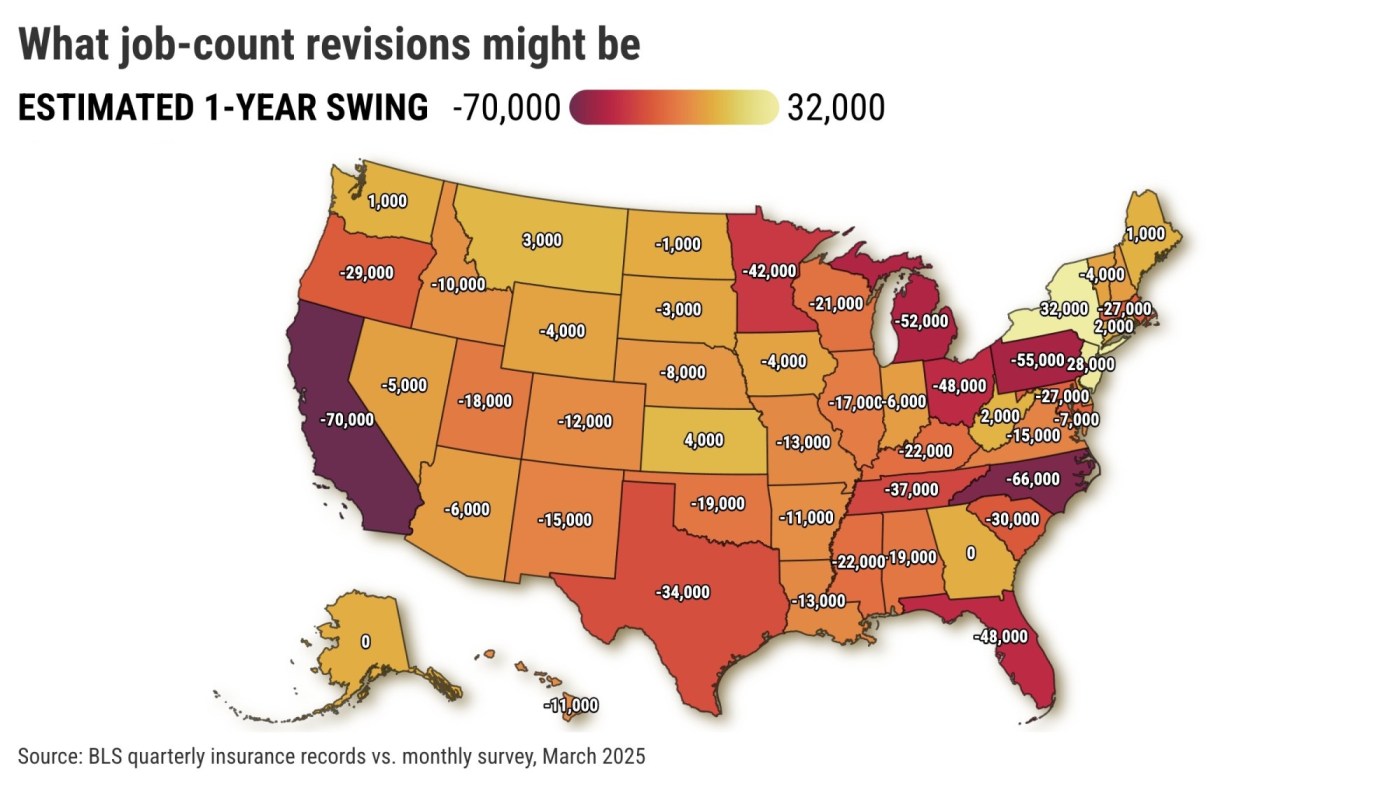New employment statistics suggest California’s job market has been significantly weaker than previously reported.
My trusty spreadsheet took a stab at estimating the geeky math that turned into a high-profile national debate: the Bureau of Labor Statistics’ routine revisions of its employment data.
Before we get into the debate, here are the highlights: California bosses added only 18,000 workers in the year ending in March, according to new job counts instead of the 88,000 previously reported. That’s a 70,000 gap, or 80% fewer jobs.
California’s slim growth helps explain 2025’s sluggish economic activity – from weak consumer confidence to tepid home and auto sales to fast-food discounting and growing government deficits. The new administration’s unorthodox business policies may also be part of the economic malaise.
The BLS math was thrust into the spotlight this summer when President Donald Trump fired the bureau’s boss in August after a huge downward revision to monthly national employment numbers. Next, the bureau announced that its first of two annual revisions of employment data showed U.S. job counts were 911,000 too high compared with previous tallies.
Government job counters refine their monthly employment counts, derived from surveys of bosses, through a two-step process. There are monthly revisions tied to additional survey results.
Annually, two revisions are largely based on quarterly job stats taken from detailed reviews of employers’ unemployment insurance filings. Those record-based counts are seen as more accurate – but they take five months to tally.
Closer to home
State and local jobs data won’t officially be updated until early 2026 after more data comes in.
In the meantime, ponder the latest records-driven counts – 2025’s first quarter – for the 50 states and the District of Columbia compared to the survey-based monthly reports for this year’s first three months. Potential revisions are not uniform across the nation, with 39 states and D.C. looking at lowered job growth.
By this calculation, the previous employment gains for California – the nation’s largest job market – appear to be 70,000 too high, as of March. That’s the biggest downward gap among the states.
North Carolina was No. 2 (66,000 too high), then Pennsylvania (55,000), and Michigan (52,000). California’s economic rivals? Texas job growth was 34,000 too high. Florida was 48,000 overstated.
Conversely, revisions could find job growth higher in 11 states, led by New York at 32,000 and New Jersey at 28,000.
This math, when applied nationwide, found an 850,000 gap between the records-based 618,000 job gain in the year ending in March and the survey’s 1.47 million gain.
That’s close to the recently announced 911,000 downward revision – so this tabulation isn’t a bad estimate.
Fresh hiring picture
The new records-driven count shows California added a slim 18,000 jobs in the year ending in March.
Still, that was 11th-best among the states. Texas was No. 1, up 168,000, followed by New York, up 137,000, and then Florida, up 90,000.
There were 12 declines led by Massachusetts, off 25,000, and Oregon, off 16,000.
Contrast that with what was previously reported by survey-driven numbers.
California was up 88,000 jobs in the year, fifth-best growth among the states. Tops were Texas, up 202,000, and Florida, up 138,000.
There were only three one-year declines: Washington, D.C., and Iowa, off 4,000, and West Virginia, off 2,000.
Part of the process
Revisions are a quirky part of the job counts. And when compared with total employment, they’re typically quite modest.
For example, California’s gap between the two job tallies equals 0.4% of total employment statewide. That was the 18th smallest among the states. Nationally, the gap was 0.5%. The largest miss was for Mississippi, at 1.8% of all jobs.
Also, it’s worth noting that the bureau was “perfect” for three states. Alaska, Georgia and Washington state had the same job changes from both counts.
Jonathan Lansner is the business columnist for the Southern California News Group. He can be reached at [email protected]
Related Articles
As cannabis market stumbles, one Northern California supplier expands
High-profile craft brewery closure will erase dozens of Bay Area jobs
California oil merger set to benefit from permitting boom
Appeals court rejects Trump’s bid to unseat Federal Reserve governor Lisa Cook ahead of rate vote
California home values drop $106 billion to $10.8 trillion
Related Articles
East Bay security company co-owners convicted of wage theft
Judge signs off on Disney’s $233 million wage theft settlement for theme park employees
High-profile craft brewery closure will erase dozens of Bay Area jobs
Bay Area cities take on Albuquerque for new $1 billion nuclear fusion site
Workers commenting on Kirk’s death learn the limits of free speech in and out of their jobs




